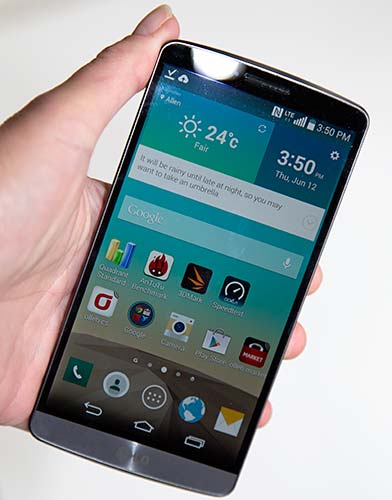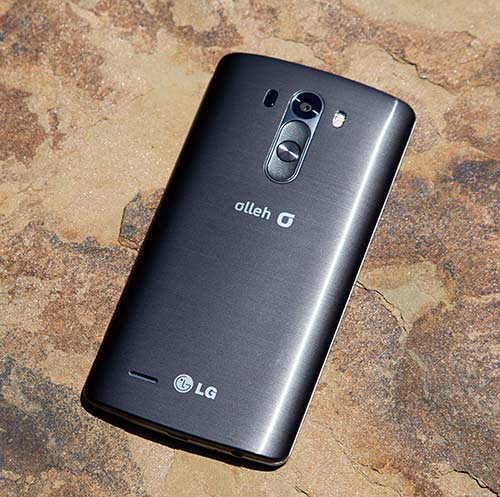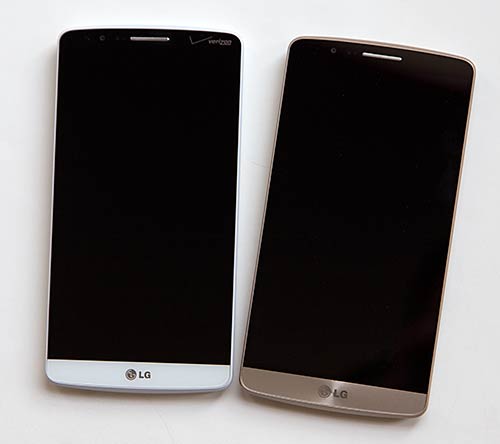LG G3 Full Review
14:18
The LG G3 is the company's flagship Android smartphone for 2014, and it's a big one, literally and figuratively. Actually, for a 5.5" phone, it's surprisingly compact, and it's not much larger than the 5" HTC One M8 and 5.1" Samsung Galaxy S5. The G3's biggest claim to fame is the impressively high 2560 x 1440 IPS display--that's the same resolution as high DPI Windows 8 laptops, but crammed into a 5.5" screen for 538 PPI density. Is that overkill? Sure it is, but it's great for marketing in a world where better than HD and 4k are big buzzwords.

The LG G3 is no slouch in other departments, with the latest, greatest Qualcomm Snapdragon 801 quad core CPU clocked at 2.5GHz, Adreno 330 graphics, 2 or 3 gigs of RAM (depending on the models your carrier will offer, US models have 3 gigs), a 13MP rear camera with neat tricks on board and a removable humungous 3,000 mAh battery. The phone has LTE 4G, dual band WiFi 802.11ac, NFC, Bluetooth 4.0 and a GPS as well as a microSD card slot. It's available on most major carriers around the world. For our video review, we used the Korean version that LG sent us before general release, but our written review is based on the AT&T, Sprint and Verizon versions of the phone.
Design and Ergonomics
LG tried their best to make the phone look like a metal unibody design, not unlike the HTC One M8. At first blush, the plastic back might just fool you and it's not as glossy or grime-prone as LG's past phones. The back is removable for access to the battery, microSD card slot and micro SIM card slot. The overall shape of the phone is much like the One M8, as is the size. The phone is available (depending on carrier) in dark silver metallic, white and gold. The silver and gold models are fairly good imitations of metal in terms of looks, the white not so much. Without resorting to crazy levels of pressure, the back casing on our AT&T, Verizon and Sprint G3 models didn't creak or distort.

As with other recent LG phones, the volume and power buttons are on the back. After using them for some time, I'm still not comfortable with that arrangement and often hit the wrong button despite tactile dips and rises. However, it does avoid that annoying problem of hitting side buttons by accident. LG's Knock On feature, where you tap the screen twice to wake up the phone (or use a knock pattern for security) obviates the need to find that power button. The G3 has on-screen buttons so there are no front mechanical or capacitive buttons to hit by accident. These do use a bit of screen real estate, but happily they automatically hide in most full screen applications like video players and games.
Display
The LG G3's unusually high resolution display has garnered lots of attention in a world where full HD 1920 x 1080 is still flagship. The 2560 x 1440, 5.5" display is both extremely sharp and roomy. It's a pleasure to use for long form reading, playing games and viewing desktop style web pages. Since it's IPS, viewing angles are wide and colors are fairly neutral. If you're accustomed to Samsung's Super AMOLED displays with their seemingly better than life color, the G3 might seem muted and the contrast less striking. The LG has a display setting where you can tweak color and contrast if you want a more Samsung-like experience, but it simply can't look that much like Super AMOLED. That doesn't mean it's not a fine display: it is lovely. We're not too keen on the simply average brightness though, and I'd wager that LG didn't want to go with a very high brightness setting in order to preserve battery life. The phone is bright enough to view outdoors, but it's not quite as easy to see the screen in sunlight as the iPhone 5s and Samsung Galaxy S5.
So does the phenomenal 538 PPI pixel density make a difference, even when compared to the 326 PPI iPhone 5s Retina display or the Galaxy S5's 432 PPI? Honestly, not so much. In our office, folks really couldn't discern individual pixels on any of these three phones (perhaps Apple is right that anything over 320 PPI is gravy). I will say that text; even small text, looks extremely sharp, and I easily used the smallest font in the Kindle and Nook apps with no eyestrain.
Performance and LG UI
The G3 runs Android 4.4 KitKat, the latest version of the Android operating system and it's customized with LG's UI enhancements. To LG's credit, they've flattened the UI and make things more consistent and simple. You won't mistake it for plain Android or HTC's clean Sense UI, but it's no longer something I'd call garish or annoying by any means. Like Samsung's TouchWiz, the LG has features like split window multitasking, a floating video player and a quick access notes app. The phone can use the front camera to sense if you're looking at the screen, and thus not turn it off, and there are motion gestures too. Other features include one-handed mode that shifts the dialer and keyboard toward the side, guest mode and Smart Cleaning that periodically cleans up temp files.

Since the LG G3 runs on the same 2.5GHz Qualcomm Snapdragon quad core CPU with Adreno graphics as competing flagship Android phones like the HTC One M8 and Samsung Galaxy S5, it benchmarks similarly. It also feels generally snappy, and the significantly higher than full HD resolution doesn't take a toll on day-to-day operations. We did notice somewhat lower frame rates in more demanding 3D titles like Asphalt 8, but they were still very playable.
Camera
The camera has laser focus (borrowed from LG's robotic vacuum division) to improve focus times and it has a two-tone LED flash for more natural flash colors. The camera has OIS+ optical image stabilization, HDR and a fairly fast f/2.4 lens. Does the laser focus really improve focus times? Yes, particularly in low light situations where phones like the Samsung Galaxy S5 hunt for focus and sometimes fail. Photos and video are among the best in good light with lots of crisp detail, good color saturation and light balance. The laser focus means fewer missed shots of zippy children and wildlife. Low light shots still have noise and a watercolor painted look where in-camera processing smoothes the noise too much. The HTC One M8 is still the winner for low light photography, even if its pixel count means less detail.
We're particularly fond of the camera's optical image stabilization that results in fewer motion-blurred shots and smoother video. 1080p and 4K video aren't the usual jarring, vertigo-inducing mess thanks to OIS, though we still slightly prefer the Samsung Galaxy S5's video quality overall. The front 2.1MP camera does selfie and video chat work and it can be used simultaneously with the rear camera.
Battery Life
It was the best of times, it was the worst of times, said Dickens. Now that's a bit extreme when speaking of the LG G3's battery life, but the G3 has either excellent battery life or so-so battery life depending on what you're doing. Stamina is impressive when browsing the web and making phone calls. I spent 1.5 hours on the phone and that used only 10% charge. When playing games, be it casual online games like Hay Day or demanding 3D games like Real Racing 3, the battery drains significantly faster. 20 minutes of Hay Day used 10% of the battery. Clearly, powering that big screen, wireless radio, CPU and graphics for demanding tasks like 3D games takes its toll.
The G3 has a removable 3,000 mAh Lithium Ion battery underneath the back cover. That's a high capacity battery by less than phablet standards, and we're glad you can swap in a spare. These days, unibody phones with permanent batteries are increasingly common.


0 comments